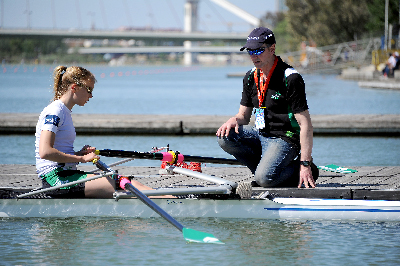|
Five Guiding Principles for Rowing Coaches
Five Guiding Principles for Rowing Coaches
By: Michael Naughton
 Drills are easy. Getting athlete’s to understand technique can be difficult. Here are some tips on translating technique from the coach’s brain to the athlete’s body. Drills are easy. Getting athlete’s to understand technique can be difficult. Here are some tips on translating technique from the coach’s brain to the athlete’s body.
1. Explain
For an athlete to master technical skills, he or she has to buy into the idea. Make sure they truly understand what you’re trying to accomplish. Drills are great for muscle memory, but understanding the “why” will allow your athletes to improve when you’re not around. Teach a small portion of the stroke at a time so athletes don’t get overwhelmed.
Example:
“This begins with good positioning and preparation to translate power to the oar. Poor catches result in missed water, disconnected drives, heavy finishes and increased potential for injury.”
2. Visualize
Now that your athletes are on board with the idea, you should show them what you want them to do. Videos, photographs and diagrams are an effective way to show how a certain technique should look.
Example:
An effective catch position is one where you have forward angle, but can retain strength in your core. Too far over, and the connection moves to your weaker lower back. Too far up, and you won’t maximize your stroke length.”
3. Train Inside
It’s much easier to explain good technique on indoor equipment. A Total-Row (Ultra-Row or Last 500) is a great way to work one-on-one with an athlete without the challenges of a dynamic system. Then move to the erg for dynamic motions, while eliminating the challenges of instability. The other benefit to working indoors is that the other athletes can watch as you work with a teammate. Ideally, they will learn to help each other when training indoors.
4. Take It On The Water

At this point, your athletes should understand the principles, have an image of what it should look like, and have practiced the technique on stationary and stable platforms. So now that you’re moving to the water with all of the other variables involved (water, weather, other rowers, etc), try to find drills that isolate the technical element of focus.
Then repeat, repeat, repeat. I recommend two to four weeks of focus on a specific area, working the drills at least twice a week. This gives the athletes a chance to get comfortable with the drills, and allows time for their “aha!” moment when they feel that stroke you’ve been describing all along.
Once they get it, keep reinforcing. Even the rowers who have already mastered the technical element will benefit from drill repetition.
Examples:
Catch Drill Sequence:
Sliding No-Catch
From the finish, slide through the recovery into the catch position, but don’t square or put the blades into the water. This allows athletes to get comfortable ending the recovery in the right position without the confusion of squaring and catching.
Sliding Catch
Same as above, but do this on the square and let the blades fall into the water. Continue to re-emphasize good positioning at the catch.
Sliding Catch, 1-Stroke
Same as above, but add a single stroke after pausing in the catch position. This allows athletes to comfortably get in the proper position before thinking about the drive.
1-Stroke
Starting from the finish, complete a full stroke without a pause at the catch. This puts what they learned together, one stroke at a time. When comfortable, add a 2nd and 3rd stroke to get comfortable with the dynamic motion at the catch.
5. Change Your Vocabulary
If some or all of your athletes are having a difficult time understanding your technique, try changing your vocabulary. What makes sense to you might not make sense to your athletes.
Example:
“Sit tall.”
“Brace your core muscles.”
“Show off your six-pack.”
“Engage your abs and obliques.”
“Shins perpendicular.”
“Bring your knees up.”
“Draw the boat under you.”
|

 NK Live Link
NK Live Link Rowing Electronics
Rowing Electronics Empower Wireless Oarlock
Empower Wireless Oarlock Features & Specifications
Features & Specifications Warranty & Customer Care
Warranty & Customer Care Manuals & Downloads
Manuals & Downloads Calibration of the SpeedCoach
Calibration of the SpeedCoach How Moving Water Affects Your SpeedCoach
How Moving Water Affects Your SpeedCoach Effects of the weather on rowing
Effects of the weather on rowing GPS & Rowing
GPS & Rowing LiNK Help Windows
LiNK Help Windows Link Help for Mac
Link Help for Mac Firmware
Firmware  Dragon Boats
Dragon Boats Surf Boats
Surf Boats Customer Feedback
Customer Feedback Mounting Brackets
Mounting Brackets Cox Box Trouble Shooting Guide
Cox Box Trouble Shooting Guide Helpful Tips & News
Helpful Tips & News
 Drills are easy. Getting athlete’s to understand technique can be difficult. Here are some tips on translating technique from the coach’s brain to the athlete’s body.
Drills are easy. Getting athlete’s to understand technique can be difficult. Here are some tips on translating technique from the coach’s brain to the athlete’s body.

